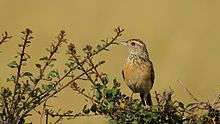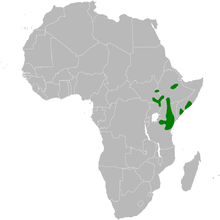Red-winged lark
The red-winged lark (Mirafra hypermetra) is a species of lark in the family Alaudidae found in eastern Africa.
| Red-winged lark | |
|---|---|
 | |
| Scientific classification | |
| Kingdom: | Animalia |
| Phylum: | Chordata |
| Class: | Aves |
| Order: | Passeriformes |
| Family: | Alaudidae |
| Genus: | Mirafra |
| Species: | M. hypermetra |
| Binomial name | |
| Mirafra hypermetra (Reichenow, 1879) | |
| Subspecies | |
|
See text | |
 | |
| resident range | |
| Synonyms | |
| |
Taxonomy and systematics
The red-winged lark is taken to form a species complex with the allopatric[2] rufous-naped lark, and perhaps with the Somali lark. The name "red-winged lark" is sometimes used as an alternate name for the Indian bush lark. The alternate names red-winged bush lark and rufous-winged bush lark may also be used to describe the Indian bush lark or the Bengal bush lark respectively.[3][4]
Subspecies
Four subspecies are recognized:[5]
- M. h. kathangorensis - Cave, 1940: Found in south-eastern Sudan
- M. h. kidepoensis - Macdonald, 1940: Found in southern Sudan and north-eastern Uganda
- Galla red-winged lark (M. h. gallarum) – Hartert, 1907: Found in Ethiopia
- M. h. hypermetra – (Reichenow, 1879): Found in southern Somalia to north-eastern Tanzania
Description
It is a larger version of the rufous-naped lark, with a more robust bill and longer tail,[6] but their morphological and vocal features do not intergrade where they occur together.[7]
Distribution and habitat
It has a patchy but quite extensive range in equatorial eastern Africa. It occurs within Ethiopia, Kenya, Somalia, South Sudan, Tanzania and Uganda, and its estimated global extent of occurrence is 660,000 km2.[1] Its total population has yet to be quantified, but is believed to be large.[1]
Its natural habitat is savanna[6] in tropical to subtropical dry, open, lowland.
References
- BirdLife International (2012). "Mirafra hypermetra". IUCN Red List of Threatened Species. 2012. Retrieved 22 November 2016.CS1 maint: ref=harv (link)
- Britton, P. L., ed. (1980). Birds of East Africa: 612. Mirafra africana Smith Rufous-naped Lark KTU 659. Nairobi: EANHS. p. 114.
- "Mirafra erythroptera – Avibase". avibase.bsc-eoc.org. Retrieved 2016-11-28.
- "Mirafra assamica – Avibase". avibase.bsc-eoc.org. Retrieved 2016-11-28.
- "IOC World Bird List 6.4". IOC World Bird List Datasets. doi:10.14344/ioc.ml.6.4.
- Sinclair, Ian; Ryan, Peter (2010). Birds of Africa south of the Sahara (2nd ed.). Cape Town: Struik Nature. p. 330. ISBN 9781770076235.
- "Rufous-naped Lark (Mirafra africana) - HBW 9, p. 551". Internet Bird Collection. Lynx Edicions. Retrieved 29 June 2016.
- Compilers: Stuart Butchart, Jonathan Ekstrom (2008). "Red-winged Lark – BirdLife Species Factsheet". Evaluators: Jeremy Bird, Stuart Butchart. BirdLife International. Retrieved May 10, 2009.
